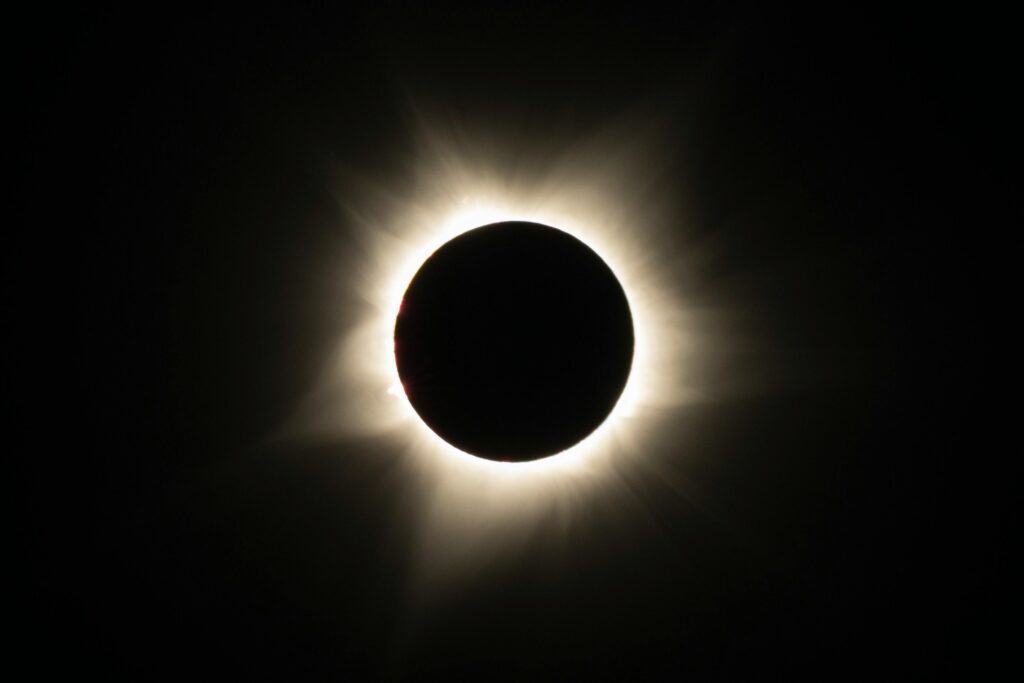
The Solar Eclipse: When the Moon Steals The Spotlight
Table of Contents
By now you’ve probably heard about the upcoming solar eclipse, but what is it? And what’s all the fuss about? We’re here to help you learn more about the natural phenomenon happening on April 8.

What is a Solar Eclipse, Anyway?
A solar eclipse occurs when the moon passes between the Sun and the Earth. During this time the moon blocks out the Sun’s light and casts a shadow across the Earth, resulting in either a partial or total eclipse. During a partial eclipse, the moon only blocks out a portion of the Sun’s light, but during a total eclipse the moon perfectly blocks out all of the Sun’s light. The eclipse on April 8, 2024 will create a total eclipse for those lucky enough to find themselves in the path of totality.
This phenomenon is not to be confused with a lunar eclipse, when the Earth passes between the Sun and moon and casts a shadow on the moon’s surface.
What’s the Big Deal?
Solar eclipses occur about twice a year on Earth, so they’re not exactly rare. However, total solar eclipses only occur once every few years. And with oceans accounting for roughly 70% of the Earth’s surface, only a fraction of total eclipses are visible from land. While the last total eclipse in the U.S. occurred only 7 years ago in 2017, the next one to be visible from the contiguous U.S. will occur on August 23, 2044. During the 2044 eclipse, totality will only be visible to those in three states: Montana, North Dakota and South Dakota. However, the path of totality on April 8 will stretch across 16 states, beginning in Texas and ending in Maine. So, for many people this eclipse may truly be a once in a lifetime opportunity!
What makes it so neat? The brief time of totality during an eclipse is the only time it is safe to look at the Sun without proper eye protection. It is NEVER safe to view a partial eclipse without proper eyewhere that adheres to the ISO 12312-2 international standard. Additionally, a total eclipse is the only time that the Sun’s corona is visible from Earth’s surface. Even cooler? If you are lucky enough to experience totality, you may even be able to see stars and even a few planets during the middle of the day!
Who will see it?
We have good news here: everybody in the contiguous U.S. will be able to see at least a partial eclipse! And while a partial eclipse isn’t quite the same experience as a total eclipse, it’s still pretty stinking cool to witness.
NASA estimates that approximately 31.6 million people are lucky enough to live within the path of totality, including residents of: Shadowland, Texas; Moon Island, Maine; and Eclipse Island, Newfoundland. Additionally, millions of people are expected to travel in order to experience this year’s total eclipse. The Texas Department of of Transportation is estimating over a million travelers to and within Texas alone!
Fun Facts
- The highest populated U.S. city in the eclipse’s path of totality is San Antonio, Texas. The next total eclipse to cast a shadow on San Antonio won’t occur until 2343!
- The temperature can drop noticeably during a solar eclipse, during the 2017 solar eclipse the National Weather Service recorded drops in temperature up to 10 degrees!
- Wildlife can act strangely during an eclipse, with the mid-day darkness throwing off their patterns and cycles. Nasa has even launched the Eclipse Soundscapes Project to study the effect of the solar eclipse on life. And the best part? YOU can submit audio or video content that you record during the eclipse!
It’s Almost Time!
So if you haven’t already, grab you some ISO 12312-2 compliant eclipse glasses, make an eclipse box viewer, or head to your computer to watch the eclipse live! Of course, we recommend some yummy eclipse-themed snacks to munch on while you watch. Happy Viewing!




